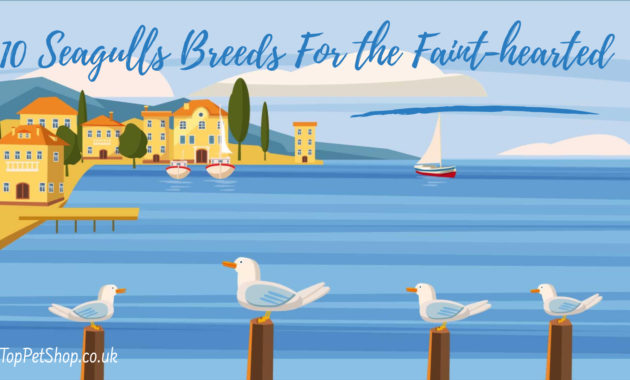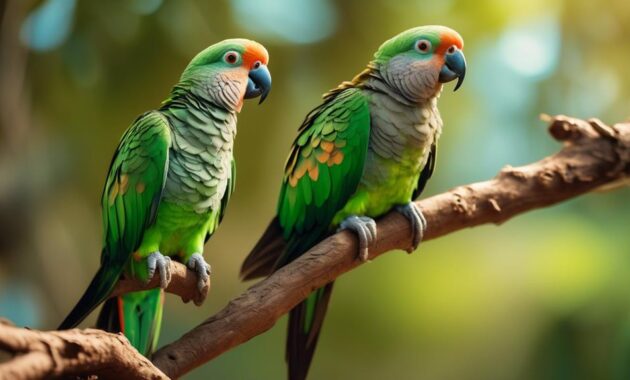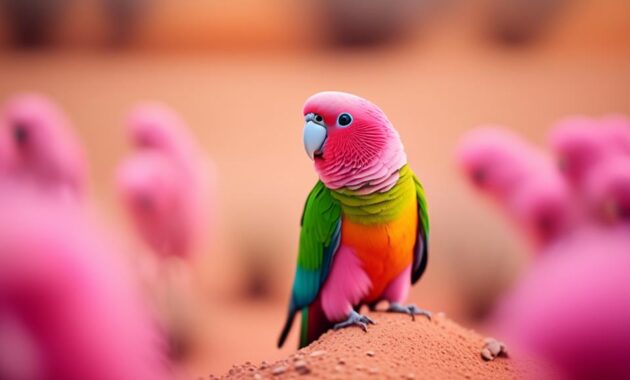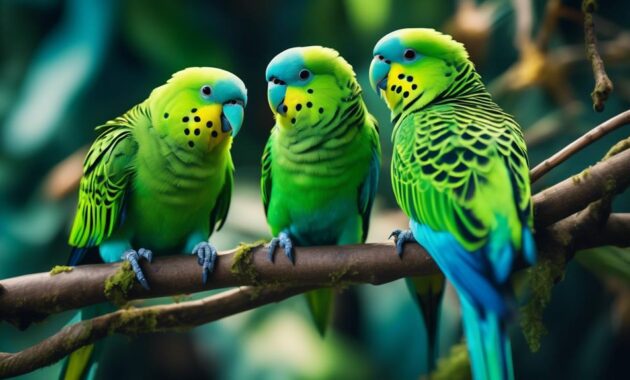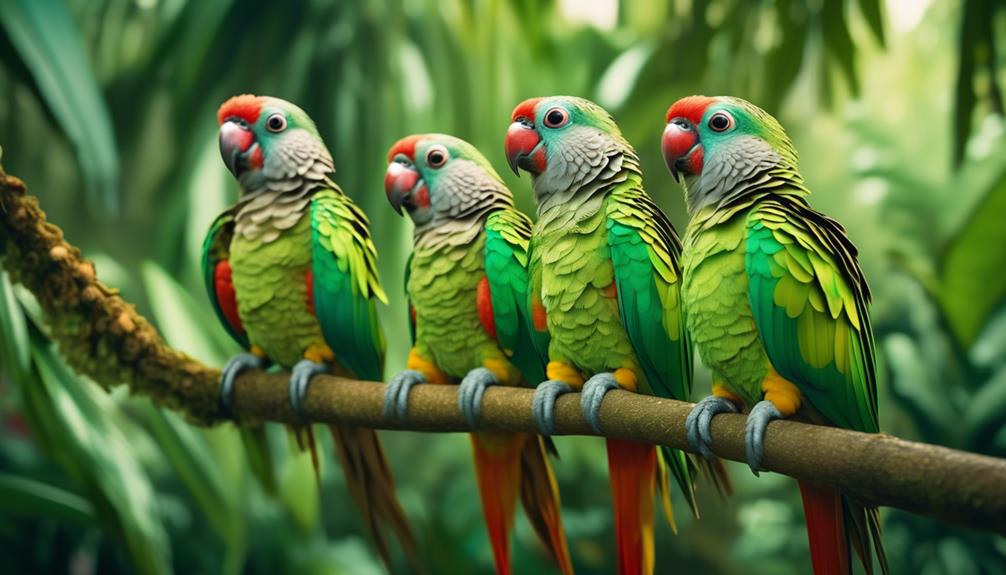
As you step into the enchanting rainforest, prepare to be captivated by a treasure beyond compare – the endangered Pearly Conures.
These vibrant birds, with their dazzling green feathers and fiery red accents, hold the key to a world brimming with beauty and wonder.
But their existence hangs by a thread, their future uncertain.
Join us on a journey as we uncover the extraordinary lives of these magnificent creatures, exploring their unique traits, their struggle for survival, and the urgent need for conservation efforts.
Brace yourself for an eye-opening adventure that will leave you yearning for more.
Key Takeaways
- Pearly Conures are small parrots with an average size of 9 inches and a lifespan of 20 to 30 years.
- They have stunning green feathers, black heads, gray necks, and red shoulder lines, making them visually captivating.
- Pearly Conures are social, playful, and enjoy interacting with their human companions.
- Habitat destruction and irresponsible policies towards wildlife pose significant threats to the survival of Pearly Conures, but conservation efforts are being made to protect their population and habitat.
Size and Lifespan of Pearly Conures
Pearly Conures, a species of Conure, are known for their vibrant colors and have an average size of approximately 9 inches and a lifespan ranging from 20 to 30 years. These small but stunning birds are a popular choice for bird enthusiasts due to their eye-catching appearance and long lifespan.
With their predominantly green feathers, black heads, and gray tones on their necks, Pearly Conures are a sight to behold. Their red shoulder lines add a touch of contrast to their overall look. In addition to their visual appeal, Pearly Conures have a quiet natural call and the ability to mimic sounds. They’re social, energetic, playful, smart, and fun to interact with.
These beautiful birds are truly a treasure of the rainforest but sadly, with only 10,000 remaining in the wild, they’re classified as vulnerable. Destruction of their habitat, logging, and flooding are the main threats they face. It’s crucial that we take action to protect these endangered Pearly Conures and preserve their natural habitat.
Colors and Appearance of Pearly Conures
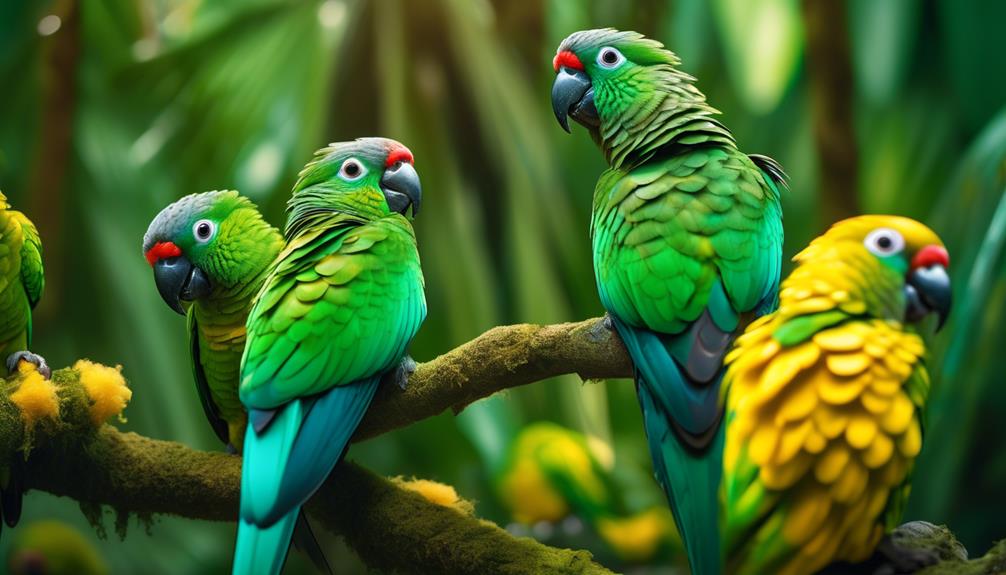
With their vibrant green feathers, striking black heads, and prominent gray tones on their necks, Pearly Conures are a visually captivating species of bird.
These beautiful birds have a predominantly green plumage, with black feathers covering their heads and necks, creating a striking contrast. Additionally, they’ve prominent gray tones on their necks, adding to their unique appearance.
One of the most eye-catching features of Pearly Conures are the red lines on their shoulders, which provide a stunning burst of color. Their overall coloration and intricate patterns make them truly stand out in their natural habitat.
It’s no wonder that Pearly Conures are admired for their vibrant and captivating colors.
Sounds and Interaction of Pearly Conures
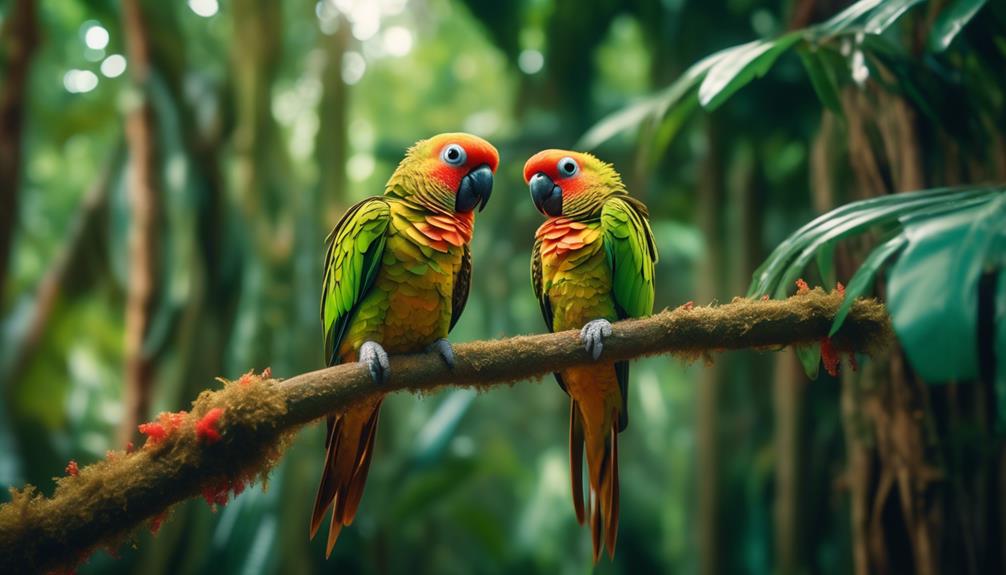
As we shift our focus to the sounds and interaction of Pearly Conures, it’s important to understand their vocalizations and social behavior.
Pearly Conures have quiet natural calls, but they can also be moderately noisy and chatterers. They’ve the ability to mimic sounds, which adds to their charm and entertainment value.
In terms of social behavior, Pearly Conures are known to be social, energetic, playful, smart, and fun. They enjoy interacting with their human companions and are affectionate and inquisitive by nature.
Their social nature makes them great companions for those who are looking for an active and engaging pet. So, if you’re considering adding a Pearly Conure to your family, be prepared for a lively and interactive experience.
Native Region and Habitat of Pearly Conures
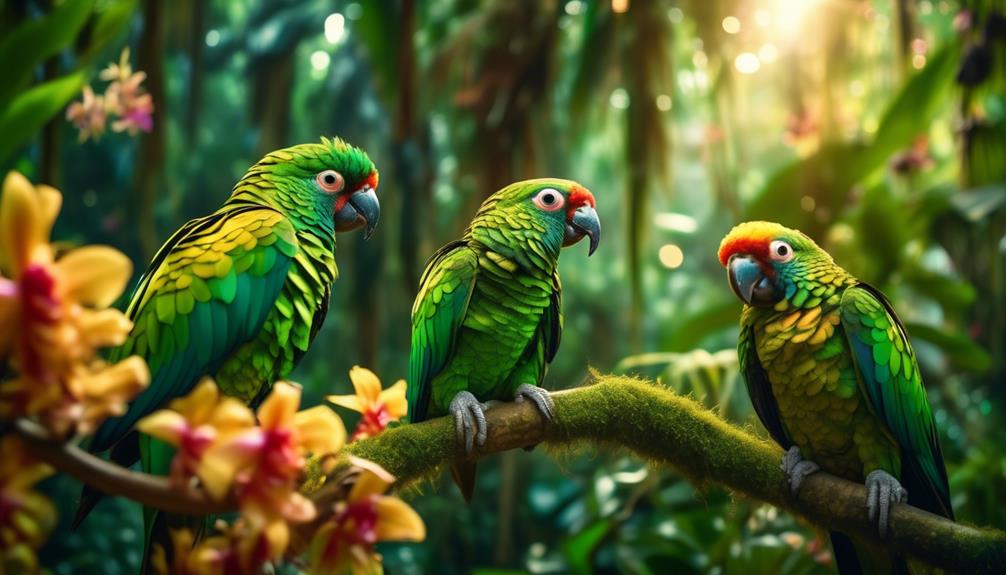
The native region and habitat of Pearly Conures is a small area in Brazil, where they’re found in tropical rainforests and the edges of these forests. These vibrant birds thrive in the lush greenery and diverse ecosystems of the rainforest. They’re well adapted to this environment and rely on the abundance of fruits, seeds, and flowers for their sustenance.
Unfortunately, their natural habitat is under threat due to deforestation, logging, and flooding. Irresponsible policies towards wildlife in Brazil have also contributed to the diminishing population of these beautiful birds. With only an estimated 10,000 Pearly Conures remaining in the wild, urgent conservation efforts are needed to protect their native region and ensure the survival of this unique species.
Threats to Pearly Conures in the Wild
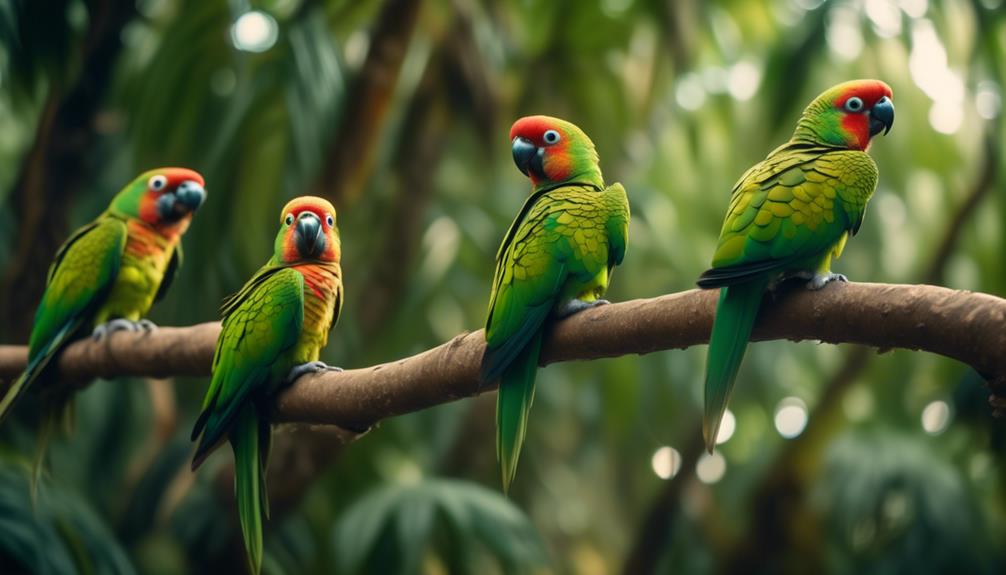
The survival of Pearly Conures in the wild is at risk due to a range of threatening factors. These threats include:
- Habitat destruction: The destruction of tropical rainforests, which are the natural habitat of Pearly Conures, poses a major threat to their survival. Deforestation, logging, and the expansion of agriculture have resulted in the loss of their nesting and feeding grounds.
- Flooding: Pearly Conures are particularly vulnerable to flooding, as their nests are often located in tree hollows. When heavy rains cause flooding, their nests can be destroyed, leading to a decline in their population.
- Irresponsible policies: Irresponsible policies towards wildlife in Brazil have contributed to the diminishing population of Pearly Conures. Lack of proper protection and conservation efforts have made it easier for these birds to be captured and traded illegally.
It is crucial to address these threats and implement effective conservation measures to ensure the survival of these vibrant rainforest treasures.
Conservation Efforts for Pearly Conures
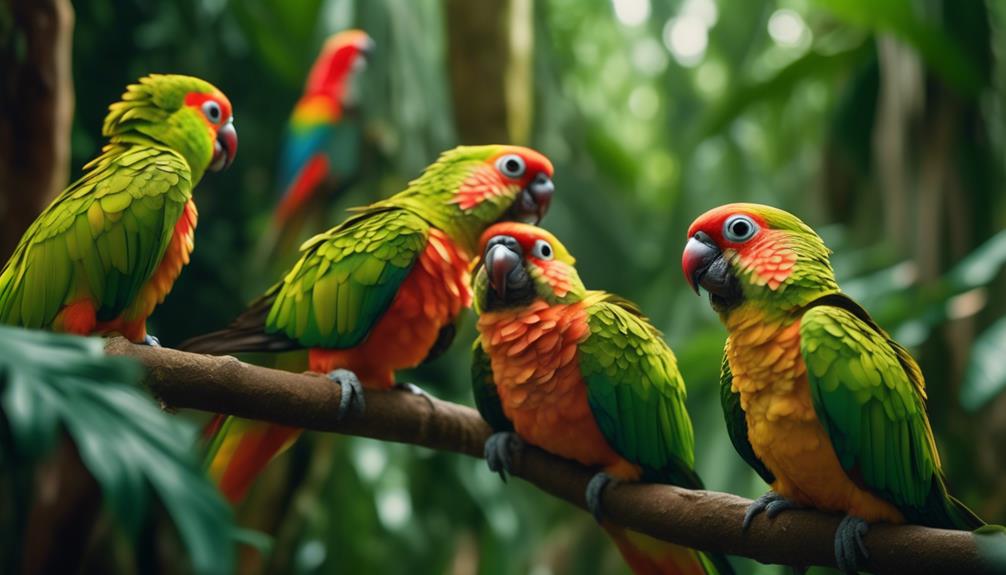
To protect the endangered Pearly Conures, conservation efforts are being implemented to preserve their dwindling population and their unique rainforest habitat. These efforts include creating protected areas and implementing strict regulations to prevent further destruction of their habitat.
Conservation organizations are working closely with local communities and governments to raise awareness about the importance of preserving the Pearly Conures and their rainforest home. They’re also conducting research to better understand the species and their ecological needs.
Additionally, captive breeding programs have been established to increase the population of Pearly Conures in captivity and potentially reintroduce them into the wild. These conservation efforts aim to ensure the survival of the Pearly Conures and protect the biodiversity of the rainforest ecosystem they rely on.
How to Help Protect Pearly Conures
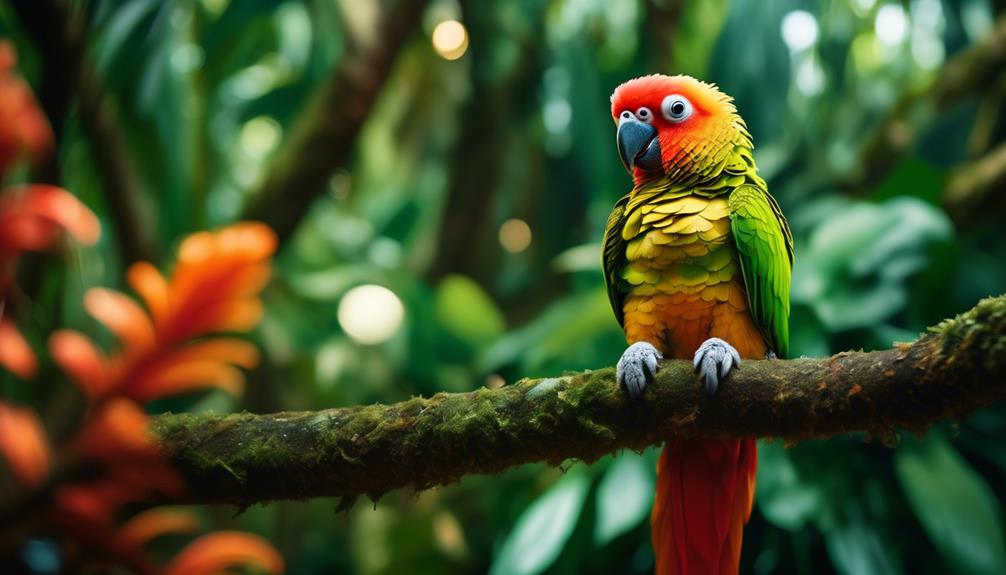
If you want to make a difference in protecting Pearly Conures, there are several actions you can take:
- Support Conservation Organizations
- Donate to reputable organizations working to protect and conserve endangered bird species like Pearly Conures.
- Join membership programs to stay updated on conservation efforts and contribute to their initiatives.
- Raise Awareness
- Share information about Pearly Conures and their endangered status on social media platforms.
- Educate others about the importance of preserving their natural habitat and the threats they face.
Frequently Asked Questions
What Is the Average Clutch Size of Pearly Conures?
The average clutch size of Pearly Conures is typically around 3-4 eggs. These vibrant birds are known for their colorful appearance and social nature, making them a treasure of the rainforest.
Do Pearly Conures Have Any Specific Dietary Requirements?
Pearly conures have specific dietary requirements. They need a balanced diet consisting of fresh fruits, vegetables, nuts, and seeds. It’s important to provide them with a variety of foods to ensure their nutritional needs are met.
Are Pearly Conures Prone to Any Specific Health Issues?
Pearly Conures, like any other parrot species, can be prone to certain health issues. It is important to provide them with a balanced diet, regular vet check-ups, and a clean environment to minimize the risks.
How Do Pearly Conures Communicate With Each Other?
Pearly Conures communicate with each other through a variety of sounds and calls. They have quiet natural calls, but can also be moderately noisy and chatterers. They even have the ability to mimic sounds.
Are Pearly Conures Known to Migrate or Stay in One Area Throughout Their Lives?
Pearly Conures, like most parrots, do not migrate. They typically stay in one area throughout their lives, usually in the tropical rainforests of Brazil.
What Threats Do Military Macaws and Pearly Conures Face in Their Natural Habitats?
The fascinating world of military macaws is not without its threats. Deforestation and illegal pet trade are the main concerns for these vibrant birds. Pearly conures, on the other hand, are at risk due to habitat loss and hunting. Conservation efforts are vital to protect these beautiful species.
Conclusion
Now that you have learned about the endangered Pearly Conures and the challenges they face, it’s clear that action is needed to protect these vibrant rainforest treasures.
With their stunning colors, social nature, and unique abilities, these birds are truly remarkable.
By supporting conservation efforts and raising awareness, we can help ensure a brighter future for the Pearly Conures and preserve their delicate rainforest habitat.
Together, we can make a difference for these magnificent creatures.

